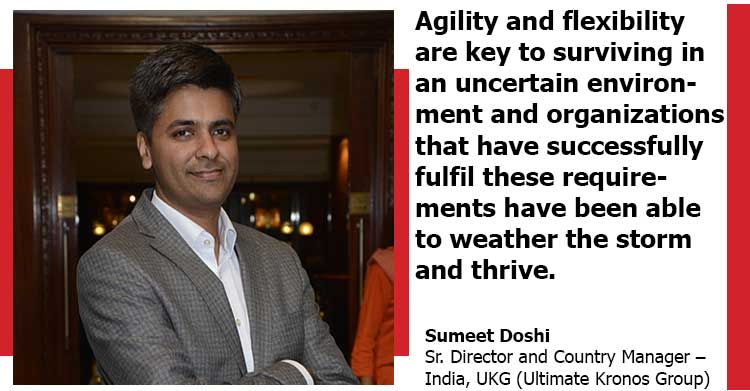The New World of Work will need to use intelligent technology for real-time talent visibility and deployment | Sumeet Doshi | Country Manager | India | Ultimate Kronos Group

2020 and 2021 have been years of disruption like no other. Even as every aspect of business right from supply chains to cashflow have been affected, the deepest impact has been in the radical changes on how the workforce operates today. It is likely that the current work from home regime for sections of the workforce will continue for a while and in turn increase the dependence of organizations on technology to manage their workforce. The events of the past few months have also made one thing very apparent. Agility and flexibility are key to surviving in an uncertain environment and organizations that have successfully fulfil these requirements have been able to weather the storm and thrive. Agility and flexibility however require access to real-time data for quick insights and execution speed. This is where technology plays a key role. Over the past few months, we have seen accelerated adoption of technology-led solutions across industries and every organization is on a fast track to digitize their workforce and enable them to be more productive from wherever they are working. While these efforts are commendable, it is important to stop and ponder on whether these digitization efforts are using the right technological tools. In the past it has been relatively simple to digitize areas like inventory management, supply chains, financial processes and many other aspects, however technology for managing the workforce is a completely different ballgame. When dealing with people, it is not just the organization’s requirements and constraints that need to be considered, but also the requirement of the workforce themselves, their skills, their preferences, and their priorities. Wherever people systems simply automate existing organizations processes and policies, it creates a certain amount of rigidity in the process which is a sure shot way of having your workforce reject it. To circumvent this, exceptions are often made which instead increase the amount of non-routine transactions and administrative work, again, defeating the very purpose of digitization and automation.
It is over here that AI and Machine learning play a significant role. Systems which leverage machine learning to understand individual preferences and accommodate them in the overall algorithm are more likely to succeed than systems that simply perform routine automation. Consider a simple case of managing shifts for employees. With traditional systems, shifts are auto-assigned to the workforce. However, when it comes to requesting for swaps based on individual preferences, because they have a cascading effect on several other activities, changes are difficult to handle and they end up getting accommodated outside the system. This in turn impacts data reliability and the ability to have an accurate real-time view into what’s happening in your operations floor. The moment we employ machine learning to take care of individual preferences while planning, schedules can be optimized online for changes immediately as a result of which execution is tracked authentically and real-time, and makes your data more reliable.
Manpower intensive industries like automotive and manufacturing, can especially benefit from these kinds of intelligent technological interventions, since it will unburden the managerial staff from manually curating schedules. Additionally with the new labour codes coming into force, factories and manufacturing units will have to do their manpower planning while being compliant with the proposed work hours, leave and rest policy. In this regard, these organizations can deploy schedule rule sets to ensure compliance with working hours, overtime limits and rest hours. Intelligent and intuitive scheduling can consider employee preferences while generating their schedules, and accordingly highlight resource availability for each job, identify shortages and find replacements with the right skills, so that overall work is not impacted. With workforce guidelines changing dynamically overnight, automation can ensure that the right team with the appropriate skill sets is scheduled to be in place. Most organizations today do have analytics and reports which give them information around various workforce metrics. The trouble with these systems is they are often mere aggregations of static data compiled over a period of time and are disconnected from execution systems. Also, with large aggregated data, outliers and anomalies are often difficult to spot. Often a compliance violation has already occurred, and we get to know about it after it has happened. Real-time workforce data is critical to identify gaps and challenges in the workforce. Analytics that can track employee hours and underscore overtime, absenteeism, productivity and even fatigue to the managerial team who can then take remedial measures to ensure that the same employees are not burdened regularly. This will help organizations not just manage their workforce easier, but also ensure better compliance, manage costs better and the end result is always an improvement in engagement and productivity.
Investments in technology are likely to pick-up, as organizations enter a new phase of volatility, uncertainty, complexity and ambiguity. Given the flux around how the pandemic has been evolving, none of us can predict what is in store for us in the future, but we can prepare ourselves to become more agile in our response. This is where tech-enabled, a utomated workforce planning solutions can help companies to be prepared for and be responsive to the changes in the work, workers and workplaces in order to smoothly navigate the Now and New Normal.


